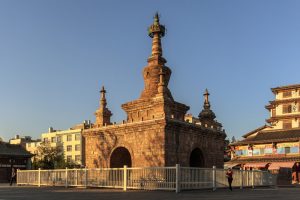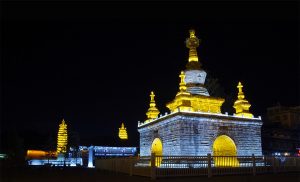Jingang Pagoda in Guandu Old Town, Kunming

Chinese Name: 昆明官渡古镇金刚塔
Chinese Pinyin: Kunming Guandu Guzhen Jingang Ta
English Name: Jingang Pagoda of Miaozhansi Temple in Guandu Old Town
Type: Pagoda, Historical & Cultural Landmark
Recommended Visiting Time: 30 minutes - 1 hour
Opening Time: All Day
Tickets Fee: Free
Address: Located in Guandu Township of Kunming City
Brief Introduction
Guandu Jingang Pagoda is located in Guandu Township of Kunming City. Guandu Old Town is usually recognizable by Jingang Pagoda in front of Miaozhan Temple. Sponsored by Luo Gui, a eunuch who garrisoned in Yunnan in the Ming Dynasty, it was constructed in 1457. (“Jingang” is a kind of pagoda construction style originating from India. Buddhist pagodas designed in this style usually comprise two parts: the pedestal and the major part. The pedestal surface appears rectangle or square while the major part turns out to be a big pagoda surrounded by four small ones)
The pagoda is said to be erected to vanquish a devastating devil locally called “Luo Si Guai” (Devil Conch). As the core of the architecture complex of Guandu Old Town, Jingang Pagoda appears to be the oldest of its kind in China.
The Structure of Jingang Pagoda

Jingang Pagoda is composed of the pedestal and the major part. The surface of the pedestal is 10.4 meters wide and long, and 4.7 meters high; its base is hollow and has four gates spacious enough for vehicles to pass through. The major part of the pagoda is five pagodas the biggest of which is as tall as 16 meters and the small four ones all measure 8.84 meters high.
What to Do here?
1. Exploring Buddhism Culture
This temple management takeover attracted its share of criticism for commercializing Buddhism, but on a recent visit we found that Guandu Shaolin Temple felt more cared-for than when it was Miaozhan Temple.
2. Studying Kung Fu
We sat down for a cup of tea and a chat with Yan Bei (延贝), the head monk from the Shaolin delegation, who told us that we could study Kung Fu for US$500 per week or US$10,000 per year, not including room and board. Not cheap, but probably worth it for martial arts enthusiasts who would rather learn Shaolin Kung Fu in sunny Yunnan than crowded and polluted Henan.
3. Tasting Local Foods

The majority of interesting things to do and see in Guandu Old Town is located south of Vajra Pagoda. A designated food street on the old town’s east side offers a wide selection of local eats including Rice Noodle(米线), Ersi (饵丝), Shao Erkuai (烧饵块), Yellow Pot Chicken, Stinky Tofu and Barbecued Chicken Feet, as well as food from further afield such as Western Yunnan and Burmese food at Ah Bo’s Burmese Cuisine or Kaili-style Sour Soup Chicken (suantang ji, 酸汤鸡).
4. Watching Kunming Opera
The old town is also home to one of the few places keeping the dying tradition of Kunming Opera (滇剧) alive. Gudu Liyuan Theater (古渡梨园) where the high-pitched singing in local dialect – Guandu’s Kunming dialect is considered the most “authentic” in the city – is accompanied by a small orchestra just offstage.
Nearby Atrractions
Major sights of Guandu Old Town can be briefed as “six temples, seven pavilions and eight shrines”, among which the earliest are Tuzhu Temple and Fading Temple.
1. Miaozhan Temple -the No. 1 of the six temples
Miaozhan Temple was first constructed in the 27th year (1290) of Zhiyuan Period of the Yuan Dynasty but was damaged by floods. It was reconstructed and shifted to the present site in 1325. There used to be two 13-storeyed dense-eave and solid pagodas of which the west one has been brought down by earthquake.
One can see a plaque inscribed with “Shao Lin Si” (Shaolin Temple). In 2008, Guandu District of Kunming and Shaolin Temple based in Songshan Mountain in Henan Province signed an agreement, according to which the latter is entitled to take over for 20 years Miaozhan Temple, Tuzhu Temple, Fa’ding Temple and Guanyin Temple in Guandu Old Town. Master Shi Yongxin, the Buddhist Abbot of Shaolin Temple, showed up to attend the opening ceremony of “Guandu Shaolin Temple”.
2. Fading Temple
Originally erected in the Nanzhao Kingdom Period (around 756), Fading Temple underwent renovation in the 21st year of Guangxu Period of the Qing Dynasty. It covers an area of about 2,500 square meters, consisting of the Main Hall, the Side Halls, the Wing Rooms and the Gate etc. Being a column-and-tie wooden structure (Chuan Dou Shi), the main hall used to be the shrine of Mahakaya. The side halls and wing rooms are shrines of Buddhist and Taoist deities such as Goddess of Mercy, God of Fortune and Yuewang King (namely Mr. Yue Fei, a brave general in the Song Dynasty).
3. Tuzhu Temple
Originally erected in the Nanzhao Kingdom Period (738-937), Tuzhu Temple covers an area of more than 5,000 square meters and serves as the shrine for Deity Mahakaya (Da Hei Tian Shen)-a protector of the Nanzhao Kingdom. Mahakaya was in fact Siva in Brahmanism in Ancient India. After converting into Buddhism, he became a Buddhist guardian. When Buddhism was introduced into the Nanzhao Kingdom (Dali Area) from Tianzhu (Ancient India), he was enshrined as a “patron god” (Tuzhu) by locals of Dali.
Best Time to Visit Jingang Pagoda
Kunming do not have harsh winter nor hot temple, and is reputed as “Spring City. ” Belonging to the humid temperate type plateau monsoon climate, the average temperature of a year here is around 15℃. With the title of City of Eternal Spring, Kunming is a destination suitable for travelling throughout the whole year. However, the best time to visit Kunming is from March to October. One can find a lot of Yunnan ethnic celebrations during these times in addition to many fruits and blossoms within this period of time. Because of this, visiting within this time will take you the most enjoyment and delight.
How to Get there?
By Bus
You can take bus No.31 in the railway station to Guandu Ancient Town, or taking bus No.165, 169, 174, 185, 908, Kunming C74, and K15 to there.
Cycling
Cycling to Guandu Old Town is easy: simply get on Qingnian Lu, ride south until Guangfu Lu and head east until reaching the intersection with 043 County Road/Baoguan Lu, following the brown bilingual signs.
By Taxi
A taxi to or from the city center will run around 40 yuan and is not advised during rush hour.
Travel tips
(1)Nearby: Kunming Luosiwan International Trade City;
(2)Hotels: Hotels available in the Old Town; or you can get back to Kunming downtown the same day;
(3)Food: Eateries and restaurants to suite all wallets there; local delicacies (snacks) are Guandu Baba (pancakes) and Er’kuai rice cakes etc;
(4)Folk Customs: You can choose to experience Guandu Temple Fair held during the Spring Festival; to see how traditional Er’kuai is made in workshops; to see Huadeng Opera and intangible cultural heritage facts etc.
(5)Climate: There is stronger sunlight during the daytime in Kunming, tourists have better take along sunscreen and sunglasses. Also people should drink more water and eat more fruit to prevent dehydration. Kunming has a saying of “Wearing the same in the four seasons” which means that Kunming has the two extremes that the seasonal variation of four seasons are change little or unable to distinguish the four seasons are the wearing characteristics of Kunming. So you can see different season clothing in the street;


















